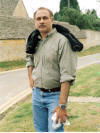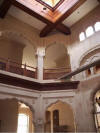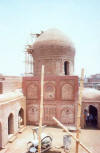|
|
the-south-asian.com July / August 2006 |
|
|||
|
August/September Contents
Sufis - wisdom against 50
years of mountain Heritage cities:
Cotton - the fibre of
|
|
||||
|
Page 4 of 4 Kamil Khan Mumtaz - The Grand Master of Traditional & Green Architecture in Pakistan (cntd.) interviewed by
Salman Minhas in Lahore, exclusively for the-south-asian. Copyright the-south-asian.com
Traditional GREEN Construction Materials: LIME SSM- As a professional, traditional designer, you recently started using limestone. Could you talk little bit about that? KKM - Well, the use of lime instead of cement is another approach to architecture. You might say this is the regional, rational response to the economic realities, and environmental concerns. In this part of the country I use bricks, which is still the cheapest permanent building material. I chose to use lime for cementing mortar and plaster, because it is half the price of cement; secondly it is much more environment friendly. The production of lime does not consume monstrous amounts of energy. It does not pollute the environment the way cement does. It does not require any high tech foreign technology, therefore, there is no foreign exchange involved; you can build a limekiln in your backyard; and in the bargain it is cool because of its hydroscopic characteristics, it absorbs moisture and is beautiful - so why not use it? [ Note : traditional craftsmen in fact claim that the limestone used as mortar – mostly mixed with earth ,or straw or jute and "Kankar" a hard material that looks like coral –and found abundantly in the Northern South Asian regions – starts to get harder as it approaches the age of 10 to 40 years – that at 40 it is in fact "jawan" [ young] . This is borne out by the fact that the old buildings, houses that were built by older cultures/periods [ Mughal, etc ] 500 years ago have withstood the test of time. The houses shown here in this article/interview by Kamil Khan Mumtaz are in fact built using these materials – the Sufi tomb – modelled after the Rauza [ tomb] of Hazrat Ali in Iraq] - near Shalimar Gardens, Lahore is in fact a stunning & , sublime piece of work that in terms of engineering & design stands out against the ugliness of the surrounding modern concrete urban kitsch houses.] SSM- Are you doing away with reinforced concrete? KKM- yes doing away with concrete is another technology. Using steel and many of these modern materials, such as glass, aluminum, also requires a lot of energy inputs. It is very expensive and dependent on foreign technology. So, we try to avoid the use of steel, as we try to avoid the use of cement. One of the ways of doing that is with brick domes, arches, and vaults. There is a very interesting traditional technique of making flat domes with bricks and lime mortars. We re-learnt and reintroduced this technique quite successfully - in both residential and other institutional buildings. SSM- Which are your favourite buildings - historical or otherwise? KKM- I think historically, I am really moved by several of the buildings in the Muslim world; but perhaps some of the most outstanding experiences have been the "Taj" and "FatehPur Sikri " these really are very, very inspiring. SSM- What was it about FatehPur Sikri? KKM- FatehPur Sikri is an architect’s architecture. Yes, it was the second capital. But in terms of the discipline, the way the space connects with spaces, structures, materials, it is so beautifully integrated into a single work of that scale. It is indeed very monumental. SSM- FatehPur Sikri as far as I remember is simply one huge structure at the top of a hill? KKM- No, it is actually an entire palace city with all the supporting structures of stables for elephants and horses, different houses, kitchens, stores, houses for Queens, princes, princesses. They are adjacent to the main structure; they are all connected, so you move from one to the other. It is a wonderful sequence. The mosque and so many other buildings make up this complex; it is a royal fortress complex. SSM- Which is your favourite, in terms of your [designed] own residences? KKM - Well I think, it is obviously the latest residence that I am doing, which happens to be Sarah Zaman’s house. With each project one moves another step forward. My latest projects are this house, and some tombs that I am doing, particularly a complex in Lahore near Shalamar Gardens. There were these two Sufi saints in Lahore. One died two and a half years ago and his master in 1968. Their graves are in a residential neighbourhood near the tomb of Madhulal Shah Hussain" [next to Shalamar Gardens]. This is one of the most exciting projects. SSM- Any other major project that you might be getting involved with in the future? KKM- It so happens that at the moment we are doing an number of mosques and tombs. We are also working on the "Mandi Baha Udin" Mosque. SSM- that’s again a restoration work or a brand new work? KKM- No: it’s a brand new work.
Significance of Muslim Tombs:
SSM- One of the questions that I have not been able to answer is that in the Islamic tradition the orthodox viewpoint is to have unmarked graves. Yet one finds the most outstanding designs and buildings, which were left behind by the Mughals, essentially being tombs. Could you talk about that, I mean apart from the contradiction, I would like you to talk about it. What was it? Was immortality the driving motivation? KKM - I’ll tell you. We came across an account of the design and construction of one of these tombs by the architect himself, a very rare document from the reign of Akbar. SSM – Was it in Persian? KKM- Originally it could have been in Persian but we got an Urdu version of it as part of a thesis in the Punjab University. This is about the tomb of Hazrat Daud Jhuniwal in Shergarh; and the account by this architect of the tomb really answers these questions. He was young, the son of a builder of no great note, but developed a keen interest in architecture, inspired by the great monuments being built in Lahore at the time. He became recognized as a master even in his teens, and would be consulted on question on designs. When the saint in question died, the young architect had an urge to pay homage to this great soul. He made a trip along with some of his colleagues to the place where the saint had died, some 40 to 50 miles from Lahore. When they arrived they found that building material was being collected. Being architects, they offered their services to the caretaker who looked them up and down, saw these young lads and said, "Yes, we are planning to build a suitable structure fro the saint. But we are looking for some one of experience and a real master as well". Disappointed, they returned home. That night this caretaker had a vision in which the saint said, "My Rauza [tomb] will be built by the young man you have turned away." The young architect was asked to design the tomb. He spent many sleepless nights sketching but couldn’t think of a suitable design. This is a familiar stage that any creative artist goes through. Eventually he gave the word for the work to start; he describes the way it was built - with devotion, enthusiasm, and zeal – and how thousands of people turned up to participate in such a virtuous work. When this structure was finished [near Okara, Renala, Dipalpur], the following description was placed on its walls. It is in Persian and begins with the usual chronogram giving the date of construction. It says: "We have built this structure, which is so beautiful that any one who sets eyes on it will be attracted towards it and he who sits beneath this dome and recites the VIRD "LA ILA HA ILLA HO" will receive from the body of this building the response "WAH DA HO LA SHREEK AALA HO". May God spread the shadow of this structure far and wide," and so on. In other words the architect gives us the reasons for its construction and its deliberately designed details. A] to attract and B] to serve as a tool in the path to God and in propagating the ideas of this sage . Thus this is the way it works. Well, I’ll give you another instance. I was asked once to participate in a workshop in Budapest and there were architects and student from Europe taking part. A part of the exercise was to design a garden around what was an old structure called "Gul Baba" and while the other groups of course went about in the usual logical manner of analysis and so on, we started and got somehow into the discussion of do you know who "Gul Baba" was? The students went and did a little research and said well all we can find out is that he was a sage in Ottoman times, much loved by everyone. Both Christians and Muslims would consult him for his wisdom. This led to the next question - Why do you think this tomb was built? So we ended up introducing Islam to the students. Suddenly I realized "Wah "Gul Baba" you have succeeded"; that was the purpose; had the tomb not been there, we would not have talked of Islam.
City Planning in South Asia – Revisited
SSM- In terms of cities is there any comparison between European and South Asian cities? KKM- One thing to note is that all the most memorable cities, and Europe is not an exception, are walking cities, which goes back to my argument - humanized urban space. SSM- Two more other important questions; one is the issue of your efforts in low cost integrated communities; the cost of land increased by a quantum jump the last year. It’s not very helpful with the prices of land being so high. It appears that the, middle class, not to talk about the lower classes, have been written off by our ruling classes who have very aggressively sought to make these so called housing societies and have conveniently chosen to write off this cross-section of the people, the working class, and consigned them to a waiting-room of History. In Denmark for example, one of the things they do is to discourage speculation, make sure that the person who buys agricultural land has the qualifications to grow food in a proper manner, yet we have these unregulated market forces driving the price of land out of reach for the middle & lower classes? KKM- You are absolutely right. The civil and military elite has ruled our country. They, like every other class, see the world in their own image. But the decisions have inevitably been with the bureaucracy who, in turn, only sees the world in their own mould. The result is exactly what you described. Defence housing schemes are the biggest land grabbers; the lowest income group is literally left to its own devices. SSM- "Khuda ki basti" [God’s dwellings] project in Karachi is perhaps one outstanding exception or the Orangi project. KKM- Yes. The ruling elite has run this country entirely in its own self interest; and built on its own image; but it is much worse than that. Every big project is conceived of as yet another occasion to loot and plunder be it "Defence Housing" schemes or "Bani-Gala" [near Rawal Lake, opposite Islamabad] or now "New Murree"; - a typical pattern. It is "Gwadar" next. The nation’s family silver, its treasures, its heritage, is just being put on the market for global capital to come and exploit; for these bureaucrats and politicians to make a quick buck; that’s how I will describe, it’s very sad but that’s how it is. Now right in front of us we have this one major scam - Gwadar [a sleepy fishing village, soon to be made into a deep-water port city in Baluchistan province – built by the Chinese, primarily for Chinese Navy and energy needs because of its strategic position sitting at the mouth of the Persian Gulf]. It is just another occasion to make a killing; free land literally and its going with government sponsorship, backing; it is going to escalate, rocket in price; and then they are surprised when the Baluch fire missiles at them. Then they wonder why the Baluch are ‘unpatriotic’. Exactly the same thing is coming up in new Murree - the new mega tourist city "New Murree" in the middle of a national forest reserve!! [ Note - Pakistan has one of the lowest Forest to land ratios in the world – the world average is 25% , in Pakistan it is 4 % ] ***** NOTES: 1. Alhambra – Spain – architect unknown . Also called Gennet-al-Aref [ Paradise of an architect] , the Lions courtyard were built by the Nasrid arab mulsim rulers in 1238-1358 - Ibn al-Ahmar, founder of the Nasrid dynasty, and his successors. Since 1492 when the Moors were driven out, much of the interior was damaged. Al Qal'a al-Hamra in Arabic means literally "the red fort". Ibn al-Ahmar rebuilt the Alcazaba- the Fortress –one of the major buildings of the Alhambra. The words wa Ia galiba illa Allah (No one conquers but Allah), which appears so many times in the decoration of its buildings amidst innumerable religious quotations and poetic lines, as proof of a spirit alive beyond mere material constructions. Most Islamic buildings, the Alhambra in Spain, Saffavid Isfahan - Iran , and the Taj Mahal, Agra, India] were metaphors for the greatness of Allah’s / God’s Throne and Paradise. The Dutch graphic designer M. C. Escher visited and remarked the Alhambra was " …….. the richest source of inspiration I have ever tapped " when he visited it in June 1922 and again in April 1936. 2.Taj Mahal - Mughal architecture created a supremely confident style by synthesizing the Persian, Timurid, Ottoman, and Indian styles. In the 1930s, a seventeenth century manuscript called the "Diwan-i-Muhandis" [ Book of Engineers], was found to list the major names involved in the making of the Taj Mahal . Taj Mahal – Mughal Architects, Engineers, Project Managers & Craftsmen-Artists: Ismail Afandi
(a.k.a. Ismail Khan) who had worked for the great Ottomans in Turkey as a
designer and builder of domes; Ustad Ahmad had a number of aliases: Ustad Khan Effendi, Ustad Mohammed, Isa Khan, Isa Effendi and a number of permutations of the name - fictional amalgam of Muslim sounding names, most likely the invention of latter-day British guidebook writers. This manuscript contains a collection of several poems written by Luft Allah, including several verses in which he describes his father, Ustad Ahmad from Lahore, as the architect of the Taj Mahal and the Red Fort at Delhi. Ahmad was a Persian engineer-astrologer. Luft Allah also states that Shah Jehan conferred upon his father the title "Nadir al-Asr" (the Wonder of the Age) Sculptors from Bukhara, calligraphers from Syria and Persia, inlayers from South India, stonecutters from Baluchistan, a man who specialized in building turrets, another who carved only marble flowers - thirty seven men in all formed the creative nucleus, and to this core was added a labor force of twenty thousand workers recruited from across North India. " Source -- http://www.pbs.org/treasuresoftheworld/taj_mahal/tlevel_2/t3build_design.html
|
|||||
|
Copyright © 2000 - 2006 [the-south-asian.com]. Intellectual Property. All rights reserved. |
|||||



